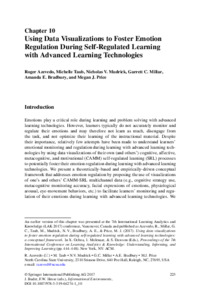 Diese Seite wurde seit 2 Jahren inhaltlich nicht mehr aktualisiert.
Unter Umständen ist sie nicht mehr aktuell.
Diese Seite wurde seit 2 Jahren inhaltlich nicht mehr aktualisiert.
Unter Umständen ist sie nicht mehr aktuell.
 Zusammenfassungen
Zusammenfassungen
 Chapter 10 (Azevedo et al., 2017) introduces a conceptual framework that
focuses on emotion regulation during learning (motivational-affective perspective).
The chapter discusses various ways to capture online assessments of cognition and
metacognition (e.g., eye tracking, log files, screen recordings) and various ways
to capture emotions (e.g., galvanic skin responses, facial expressions). It is also
discussed how an environment can be designed that captures all these data online and adaptively feeds them back to a learner in order to foster emotion regulation.
Providing learners with a suite of data about their own cognitions and emotions is
an example of assistive adaptivity.
Chapter 10 (Azevedo et al., 2017) introduces a conceptual framework that
focuses on emotion regulation during learning (motivational-affective perspective).
The chapter discusses various ways to capture online assessments of cognition and
metacognition (e.g., eye tracking, log files, screen recordings) and various ways
to capture emotions (e.g., galvanic skin responses, facial expressions). It is also
discussed how an environment can be designed that captures all these data online and adaptively feeds them back to a learner in order to foster emotion regulation.
Providing learners with a suite of data about their own cognitions and emotions is
an example of assistive adaptivity. Emotions play a critical role during learning and problem solving with advanced learning technologies. However, learners typically do not accurately monitor and regulate their emotions and may therefore not learn as much, disengage from the task, and not optimize their learning of the instructional material. Despite their importance, relatively few attempts have been made to understand learners´ emotional monitoring and regulation during learning with advanced learning technologies by using data visualizations of their own (and others´) cognitive, affective, metacognitive, and motivational (CAMM) self-regulated learning (SRL) processes to potentially foster their emotion regulation during learning with advanced learning technologies. We present a theoretically-based and empirically-driven conceptual framework that addresses emotion regulation by proposing the use of visualizations of one´s and others´ CAMM-SRL multichannel data (e.g., cognitive strategy use, metacognitive monitoring accuracy, facial expressions of emotions, physiological arousal, eye-movement behaviors, etc.) to facilitate learners´ monitoring and regulation of their emotions during learning with advanced learning technologies. We use examples from several of our laboratory and classroom studies to illustrate a possible mapping between theoretical assumptions, emotion-regulation strategies, and the types of data visualizations that can be used to enhance and scaffold learners´ emotion regulation, including key processes such as emotion flexibility, emotion adaptivity, and emotion efficacy. We conclude with future directions that can lead to a systematic interdisciplinary research agenda that addresses outstanding emotion regulation-related issues by integrating models, theories, methods, and analytical techniques for the areas of cognitive, learning, and affective sciences, human computer interaction, data visualization, big data, data mining, data science, learning analytics, open learner models, and SRL.
Emotions play a critical role during learning and problem solving with advanced learning technologies. However, learners typically do not accurately monitor and regulate their emotions and may therefore not learn as much, disengage from the task, and not optimize their learning of the instructional material. Despite their importance, relatively few attempts have been made to understand learners´ emotional monitoring and regulation during learning with advanced learning technologies by using data visualizations of their own (and others´) cognitive, affective, metacognitive, and motivational (CAMM) self-regulated learning (SRL) processes to potentially foster their emotion regulation during learning with advanced learning technologies. We present a theoretically-based and empirically-driven conceptual framework that addresses emotion regulation by proposing the use of visualizations of one´s and others´ CAMM-SRL multichannel data (e.g., cognitive strategy use, metacognitive monitoring accuracy, facial expressions of emotions, physiological arousal, eye-movement behaviors, etc.) to facilitate learners´ monitoring and regulation of their emotions during learning with advanced learning technologies. We use examples from several of our laboratory and classroom studies to illustrate a possible mapping between theoretical assumptions, emotion-regulation strategies, and the types of data visualizations that can be used to enhance and scaffold learners´ emotion regulation, including key processes such as emotion flexibility, emotion adaptivity, and emotion efficacy. We conclude with future directions that can lead to a systematic interdisciplinary research agenda that addresses outstanding emotion regulation-related issues by integrating models, theories, methods, and analytical techniques for the areas of cognitive, learning, and affective sciences, human computer interaction, data visualization, big data, data mining, data science, learning analytics, open learner models, and SRL. Dieses Kapitel erwähnt ...
Dieses Kapitel erwähnt ...
 Begriffe KB IB clear | cognitive load theory (CLT) |
 Anderswo finden
Anderswo finden
 Volltext dieses Dokuments
Volltext dieses Dokuments
 |  Using Data Visualizations to Foster Emotion Regulation During Self-Regulated Learning with Advanced Learning Technologies: Artikel als Volltext bei Springerlink ( Using Data Visualizations to Foster Emotion Regulation During Self-Regulated Learning with Advanced Learning Technologies: Artikel als Volltext bei Springerlink ( : :  , 198 kByte; , 198 kByte;  : :  ) ) |
 Anderswo suchen
Anderswo suchen 
 Beat und dieses Kapitel
Beat und dieses Kapitel
Beat hat Dieses Kapitel während seiner Zeit am Institut für Medien und Schule (IMS) ins Biblionetz aufgenommen. Beat besitzt kein physisches, aber ein digitales Exemplar. Eine digitale Version ist auf dem Internet verfügbar (s.o.). Aufgrund der wenigen Einträge im Biblionetz scheint er es nicht wirklich gelesen zu haben. Es gibt bisher auch nur wenige Objekte im Biblionetz, die dieses Werk zitieren.











 Biblionetz-History
Biblionetz-History